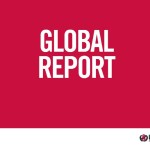
Parts of this post originally appeared on Notes From the Field, a blog written by Art for AIDS International board member JP Bervoets.
This past week UNAIDS released the 2010 Report on the Global AIDS Epidemic. In it, UNAIDS highlights a number of key successes that seem to suggest that the HIV/AIDS pandemic has passed peak infection levels. One statistic in particular has been drawing considerable media attention: New infections have dropped by 20% globally.
While this statistic is worth considerable celebration, a complex global epidemic is unfortunately not so easy to read, and significant challenges still lie ahead with regard to ensuring that there is a continued decrease in new infections from hereon out. Part of this challenge lies in unpacking the data and continuing to dedicate considerable attention and capital to ensuring targets are met in an efficient, effective, and measurable manner; the other part comes from celebrating our tremendous progress and continuing to passionately push for change. Here are a few stats to consider that should provide a much needed jolt:
- While there has been roughly a 20% decrease in new infections over the past decade, more than 7000 people are infected with the HIV virus each day.
- For every one person who is put on treatment, there are two new infections.
- While over 5 million people are receiving antiretroviral treatment, 30 million people are infected and 10 million are in immediate need of treatment.
Many of these issues were addressed by former UN Special Envoy for AIDS Stephen Lewis in a Globe and Mail article published Monday November 29th. In it, Lewis succinctly highlights the need for a renewed commitment by the public and private sector alike in a time when funding for HIV/AIDS is “flat-lining” and even reducing in some cases.
“At the moment, the biggest single obstacle is resources, is the dollars. There’s just no question about that. We have made progress in providing treatment. We have various forms of prevention, from microbicides to male circumcision to behaviour change. We are working very hard, increasingly hard, with high-risk groups, like men having sex with men and sex workers and injecting drug users. There is a sense of some momentum as the application of treatment results in prevention…There are significant things happening; you sense that we might turn the tide on this pandemic. But now the resources are flat lining and reducing and that is incomprehensible. It’s just outrageous that the people of Africa in particular should be considered expendable because the donor countries will not honour their commitments.”
This World AIDS Day, please make a concerted effort to get out and support your local AIDS Organization, attend an event, and learn more about how you can help end the HIV/AIDS pandemic. Art for AIDS International will be hosting events on Wednesday Dec 1st, and Thursday Dec 2nd. More information can be found on our website at www.artforaidsinternational.org.
For more details about the Stephen Lewis Foundation please visit their website.
